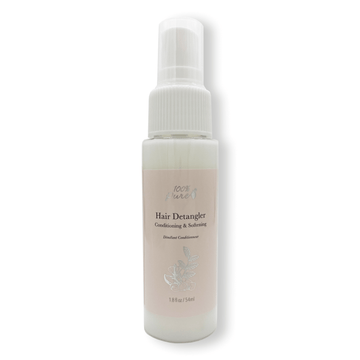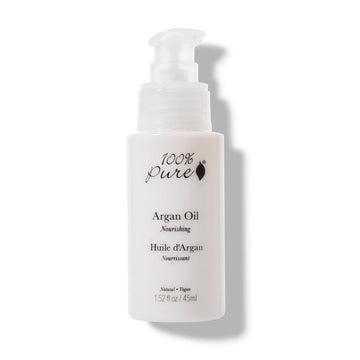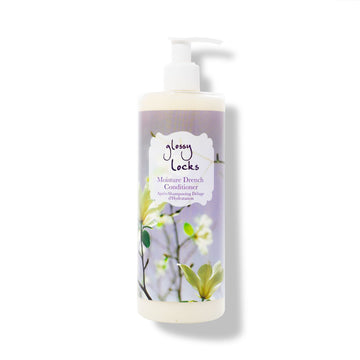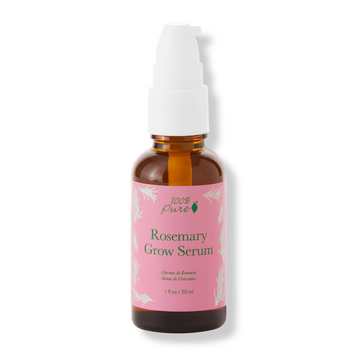A Complete Guide Based on Hair Type & Science
Posted on March 11, 2025 Written by: 100% PURE®
Few things are as frustrating as trying to run your fingers through your hair, only to be met with stubborn knots and tangles. Whether your strands are straight, wavy, curly, or coily, detangling is a non-negotiable step in maintaining healthy, strong, and beautiful hair. But here's the big question: Should you be detangling your hair when it’s dry or wet?
The answer isn't one-size-fits-all. The best method depends on your hair type, the tools you use, and the products that support the process. Detangling the wrong way can lead to breakage, split ends, and unnecessary damage, while the right approach can make all the difference in keeping your hair smooth, healthy, and manageable.
That’s where 100% PURE comes in. Committed to clean beauty, 100% PURE offers a range of natural, nutrient-rich hair care solutions that make detangling easier, safer, and more effective. Whether your hair needs extra slip, hydration, or strengthening, their formulas—free from harmful sulfates, silicones, and synthetic additives—help ensure a gentle and nourishing detangling experience.
Now, let’s dive into why detangling matters and how to do it the right way for your hair type.
Why Detangling Matters for Hair Health
Tangled hair isn’t just a minor annoyance—it can lead to serious hair damage if not properly managed. When knots and tangles are left unchecked, they can cause:
-
Breakage: Tugging on tangled strands can snap the hair shaft, leaving behind weaker, frayed ends.
-
Split Ends: Rough detangling leads to split ends, which make hair look dull, dry, and unhealthy.
-
Frizz & Unruliness: Knots disrupt the smooth alignment of hair strands, leading to frizz, uneven texture, and styling difficulties.
The Hidden Risks of Using the Wrong Tools & Methods
Not all detangling techniques are created equal. Using the wrong tools or approach can cause more harm than good. For example:
❌ Brushing wet hair without the right product can stretch and snap fragile strands.
❌ Using a fine-tooth comb on thick or curly hair can cause unnecessary pulling and damage.
❌ Skipping a detangling product makes the process harder and more damaging than it needs to be.
The Solution: 100% PURE Conditioning Detangler
To minimize damage, using the right product is just as important as using the right method. That’s where the 100% PURE Conditioning Detangler comes in.
🌿 Why It’s a Must-Have for Detangling:
✔ Reduces friction and allows your brush or comb to glide effortlessly.
✔ Moisturizes and nourishes the hair while preventing breakage.
✔ Works for all hair types, whether detangling wet or dry.
By using a gentle, natural detangler like 100% PURE Conditioning Detangler, you’re not only

Detangling Dry Hair – When and How to Do It
Who Should Detangle Dry?
Dry detangling is best suited for straight and wavy hair since these hair types tend to be structurally weaker when wet. Wet hair has more elasticity, making it prone to stretching and snapping—especially in fine, straight strands. By detangling while dry, you can minimize excessive breakage and better control knots without causing unnecessary strain on the hair shaft.
If you have straight or wavy hair, dry detangling is the safer option, provided you use the right tools and products to avoid friction and breakage.
How to Properly Detangle Dry Hair
🔹 Step 1: Prep with a Lightweight Detangler
Before starting, apply a detangling spray like 100% PURE Conditioning Detangler. This helps loosen knots, reduces resistance, and protects the hair from friction. The lightweight formula allows your brush or comb to glide through more smoothly, preventing tugging and breakage.
🔹 Step 2: Use a Wide-Tooth Comb or Detangling Brush
Instead of a fine-tooth comb, which can cause unnecessary breakage, opt for a wide-tooth comb or a brush designed for detangling dry hair. Always start at the ends and gradually work your way up to the roots to prevent pulling and snagging.
🔹 Step 3: Seal in Moisture with 100% PURE Argan Oil
Once detangled, apply a few drops of 100% PURE Argan Oil to hydrate, smooth, and protect your strands. This lightweight oil nourishes the hair, reduces frizz, and adds a healthy shine without weighing it down.
Pros of Dry Detangling
✅ Reduces the risk of overstretching and snapping strands that are more fragile when wet.
✅ Helps identify and target knots more easily in straight or wavy textures.
Cons of Dry Detangling
❌ Can create friction and breakage in curly, coily, or textured hair types.
❌ May take longer to work through severely tangled hair.
Detangling Wet Hair – When and How to Do It
Who Should Detangle Wet?
Wet detangling is ideal for curly, coily, and textured hair, which is more prone to shrinkage and tangling when dry. Because these hair types require more moisture, detangling while wet (with the help of a slippery conditioner) helps reduce friction and prevents excessive breakage.
If you have tight curls or coils, detangling dry may lead to painful snagging and breakage. Instead, wet detangling allows for a gentler, more manageable process.
How to Properly Detangle Wet Hair
💦 Step 1: Start with a Hydrating Cleanse
Begin by washing your hair with 100% PURE Glossy Locks Moisture Drench Shampoo. This ultra-nourishing shampoo hydrates and softens strands, making the detangling process much smoother from the start.
💦 Step 2: Apply a Conditioner with Slip
Next, generously apply 100% PURE Glossy Locks Moisture Drench Conditioner to your damp hair. Let it sit for a few minutes to soften the strands and add slip, making it easier to glide through tangles without pulling.
💦 Step 3: Finger-Detangle Before Using a Comb
Before reaching for a brush or comb, use your fingers to gently separate larger knots. This helps minimize unnecessary tension and breakage.
💦 Step 4: Use a Wide-Tooth Comb or Wet Brush
Once you've loosened major tangles with your fingers, use a wide-tooth comb or wet brush to work through the remaining knots—starting from the ends and moving upward.
💦 Step 5: Nourish with 100% PURE Rosemary Grow Serum
After detangling, apply a few drops of 100% PURE Rosemary Grow Serum to your scalp. This lightweight, botanical-infused serum stimulates healthy hair growth, strengthens the strands, and keeps the scalp nourished.
Pros of Wet Detangling
✅ Reduces friction and breakage in curly, coily, and textured hair.
✅ Conditioner provides extra slip, making knots easier to remove without excessive tugging.
Cons of Wet Detangling
❌ Hair is at its weakest when wet, making rough handling a major risk for breakage.
❌ Without proper preparation, severe tangles can worsen, especially if hair is extremely knotted before adding water.

Key Takeaways – Which Method Is Right for You?
When it comes to detangling, there’s no one-size-fits-all approach—it all depends on your hair type, texture, and the products you use. Here’s a quick reference guide to help you choose the best method:
Hair Type |
Best Detangling Method |
Recommended 100% PURE Products |
|---|---|---|
Straight/Wavy |
Dry |
|
Curly/Coily |
Wet (with conditioner) |
100% PURE Glossy Locks Moisture Drench Shampoo, 100% PURE Glossy Locks Moisture Drench Conditioner, 100% PURE Rosemary Grow Serum |
🔹 Universal Tip: Always detangle gently and avoid aggressive towel drying before detangling, as it can create more tangles and cause unnecessary breakage. Instead, use a soft microfiber towel or cotton T-shirt to gently squeeze out excess water without disturbing the hair cuticle.
Frequently Asked Questions (FAQs)
1. Can I detangle my hair both wet and dry?
Yes, but it depends on your hair type!
-
Straight and wavy hair generally benefits from dry detangling to avoid unnecessary breakage when strands are fragile and wet.
-
Curly and coily hair thrives with wet detangling using conditioner, which provides the necessary slip to prevent breakage.
2. How often should I detangle my hair?
This varies depending on hair type and routine:
-
Straight/Wavy Hair: 2-3 times per week to prevent excessive shedding.
-
Curly/Coily Hair: Every wash day or more frequently, depending on styling and hair texture.
3. What’s the best way to prevent tangles?
Use a silk pillowcase – Reduces friction and prevents hair from tangling overnight.
Keep hair moisturized – Use 100% PURE Argan Oil to lock in hydration and smooth strands.
Avoid heat damage and rough towel drying – Always gently squeeze water from your hair instead of rubbing it with a towel.
4. What happens if I don’t detangle my hair?
Neglecting your hair can lead to severe knots, breakage, and even matting—which can cause irreversible damage over time. If left unmanaged, mats and knots may need to be cut out, leading to loss of length and compromised hair health.
5. Can the wrong detangling method cause hair loss?
Yes! Using the wrong tools and techniques—such as forcing a fine-tooth comb through tangled hair or skipping a detangling product—can lead to excessive shedding, snapping, and breakage. To protect your hair, always:
✔ Use the right detangling method for your hair type.
✔ Work in sections to minimize pulling.
✔ Use nourishing products like 100% PURE Conditioning Detangler to reduce friction.
Detangling isn’t just about keeping your hair looking neat—it’s a critical step in maintaining strong, healthy strands. By choosing the right detangling method based on your hair type, using the proper tools and products, and being gentle, you can prevent breakage, reduce frizz, and keep your hair looking its best.
Looking for natural, nourishing hair care solutions? 100% PURE’s range of hair care including detanglers, conditioners, and oils make the process effortless—while keeping your hair free from harmful chemicals.
- Tags: March-2025
We carefully hand-select products based on strict purity standards, and only recommend products we feel meet this criteria. 100% PURE™ may earn a small commission for products purchased through affiliate links.
The information in this article is for educational use, and not intended to substitute professional medical advice, diagnosis, or treatment and should not be used as such.


















